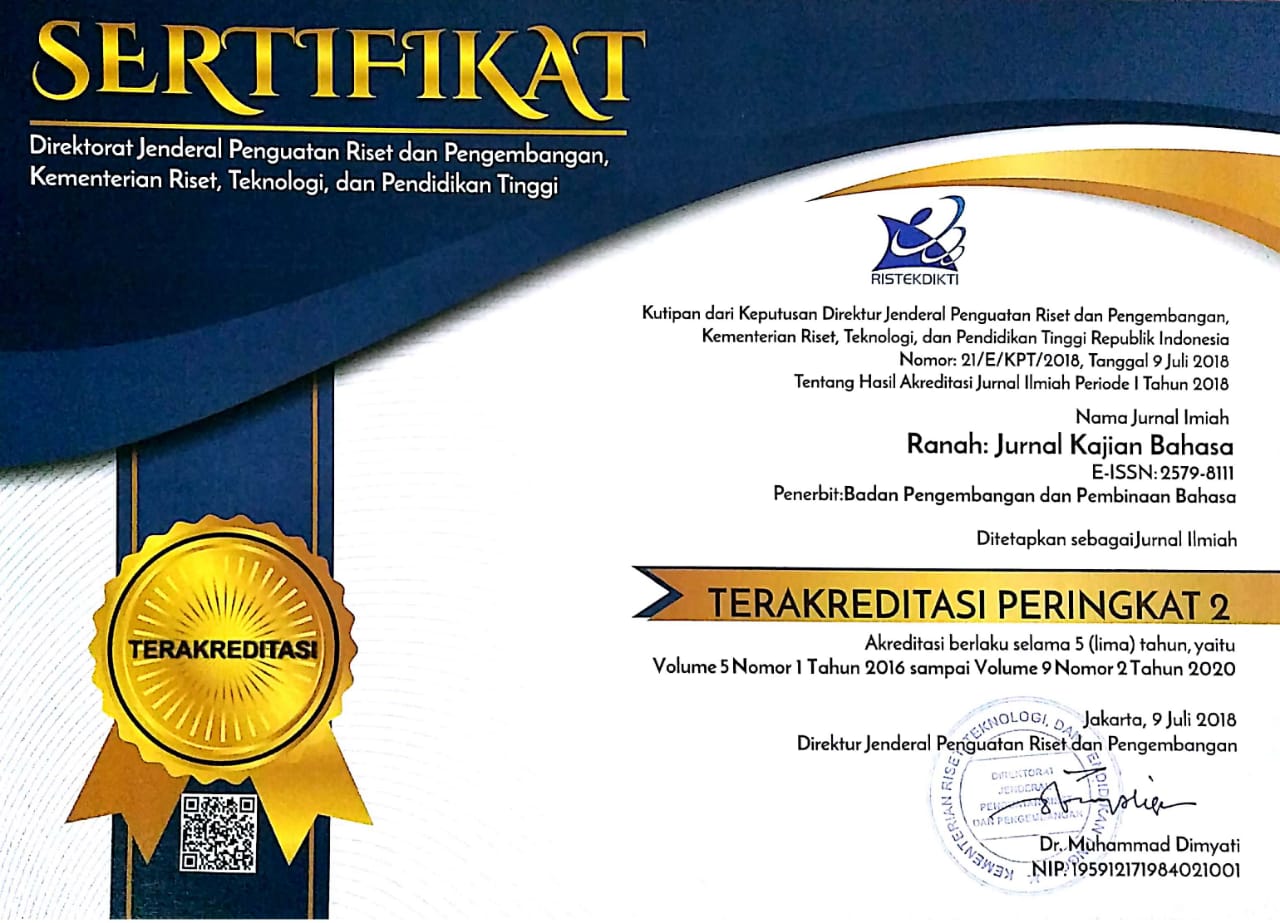HUKUM TARIK-MENARIK DALAM NOVEL KLASIK UNDER THE GREENWOOD TREE KARYA THOMAS HARDY
Abstract
Paulo Coelho dalam buku The Alchemist pernah berkata bahwa, “ketika kamu menginginkan sesuatu, alam semesta berkonspirasi untuk membantumu mencapainya.” Mendapatkan apa yang diinginkan pada praktiknya tidak sesederhana itu. Dalam Under The Greenwood Tree, Dick Dewy tidak hanya menginginkan Fancy Day sebatas keinginan saja. Dick harus melakukan beberapa hal guna memastikan Fancy jatuh ke dalam pelukannya. Hukum tarik-menarik (the law of attraction) yang menjadi dasar rujukan penelitian ini bekerja secara universal menarik ke dalam kehidupan seseorang, apa pun (baik positif maupun negatif) yang orang itu berikan perhatian, energi, dan fokus. Menggunakan novel romance klasik karya Thomas Hardy, penelitian ini bertujuan untuk mengungkapkan upaya-upaya Dick dalam mendapatkan Fancy. Penggunaan metode kualitatif dan teori the law of attraction yang dikembangkan Michael J. Losier membuat penelitian ini menemukan bahwa Dick menerapkan tiga proses dalam the law of attraction dalam mendapatkan Fancy. Tiga proses tersebut adalah law of attraction, law of creating, dan law of allowing.
Kata-kata kunci: Hukum Tarik-Menarik, Thomas Hardy, Era Victoria, Sastra Banding, Michael J. Losier.
Keywords
Full Text:
PDF (Bahasa Indonesia)References
Atkinson, William Walker. (2018). Thought vibration or, the law of attraction in the thought world—The classic original edition from 1906. Compass Circle.
Bond, Sandra. 2009. “The law of attraction”. M.Msc Thesis, University of Sedona, Arizona.
Brown, Marshall. (2007). Attraction: Getting what you want to come to you. Water Resources IMPACT, 9(3), 28–29. JSTOR.
Byrne, Rhonda. 2006. The Secret. New York: Atria Books
——————. 2007. The Secret: Rahasia (e-book). Jakarta: Gramedia Pustaka Utama.
Canfield, Jack. (2016, February). 5 Secrets To Activating The Laws of Attraction. LifeHealthPro.
Creswell, John W. (2009). Research design: Qualitative, quantitative, and mixed methods approaches (3rd ed). Sage Publications.
du Plessis, Erik Mygind. (2020) ‘How to Perpetuate Problems of the Self: Applying Foucault’s Concept of Problematization to Popular Self-Help Books on Work and Career’, Culture and Organization. https://doi.org/10.1080/14759551.2020.1752691.
—————————. (2020). ‘Be a model, not a critic’: Self-help culture, implicit censorship and the silent organization. Organization, 135050842093923. https://doi.org/10.1177/1350508420939230.
Hashimoto, Serena Dawn. (2018). prophetic performatives: The new age’s pending efficacy through self-prophecy. Culture and Religion, 19(2), 217–234. https://doi.org/10.1080/14755610.2018.1444652.
Hardy, Thomas. 1994. Under The Greenwood Tree (e-book). Hertfordshire: Wordsworth Editions.
Hicks, Esther and Jerry. 2004. Ask and It Is Given: Learning to Manifest Your Desires. California: Hay House.
—————————. 2006. The law of attraction. California: Hay House.
Idris, Akhmad. (2019). Pengambilan Keputusan Etis Dalam Novel Burlian Karya Tere Liye: Kajian Literasi Moral. Bahasa dan Seni: Jurnal Bahasa, Sastra, Seni, dan Pengajarannya Vol. 47 No. 1, 1–9.
Jati, G. P. (2020). Transmisi Memori dan Wacana Rekonsiliasi dalam Cerpen “Perempuan Sinting Di Dapur” Karya Ugoran Prasad: Kajian Postmemory. JENTERA: Jurnal Kajian Sastra, 9(1), 28-42. https://doi.org/10.26499/jentera.v9i1.2265
Losier, Michael J. 2007. Law of attraction: The Science of Attracting More of What You Want and Less of What You Don’t. New York dan Boston: Wellness Central.
Mullins, Eddie. 2008. “The Process of the law of attraction and The 3rd Law, Law of allowing” paper submitted in partial fulfillment of the requirements for the Master of Science Degree in Training and Development, University of Wisconsin-Stout, August 2008.
Nurdin, M. (2012). The law of attraction dan doa dalam islam. Dialogia: Jurnal Studi Islam Dan Sosial, 10(2), 227–240. https://doi.org/10.21154/dialogia.v10i2.314
Parker, Martin. (2006) ‘The Counter Culture of Organisation: Towards a Cultural Studies of Representations of Work’, Consumption, Markets and Culture 9(1): 1–15.
Rehn, Alf. (2008) ‘Pop (Culture) Goes the Organization: On Highbrow, Lowbrow and Hybrids in Studying Popular Culture within Organization Studies’, Organization 15(5): 765–783.
Rimke, Heidi Marie. (2000) ‘Governing Citizens through Self-Help Literature’, Cultural Studies 14(1): 61–78.
Wardani, A. N. (2019). Hegemoni Maskulinitas dalam Under The Greenwood Tree Karya Thomas Hardy. Satwika : Kajian Ilmu Budaya Dan Perubahan Sosial, 2(2), 68-78.
Weber, Kerry. (2014, December). Laws of Attraction: Love and loss in ‘The Theory of Everything’. America, 211(17), 30–31.
DOI: https://doi.org/10.26499/jentera.v10i1.3492
Refbacks
- There are currently no refbacks.






















